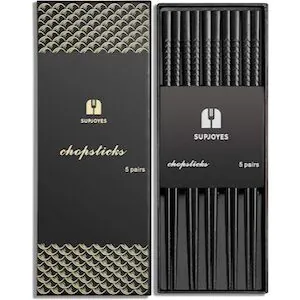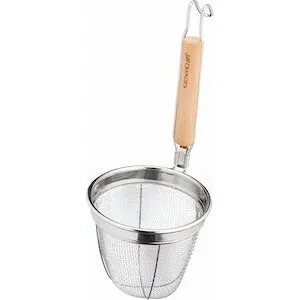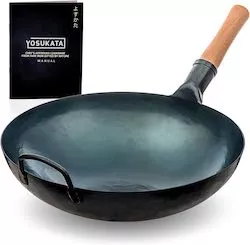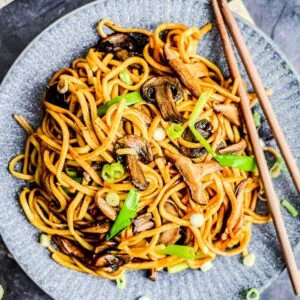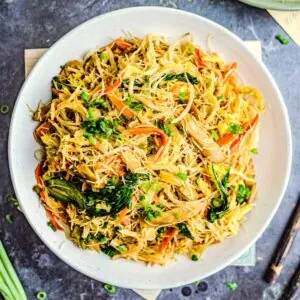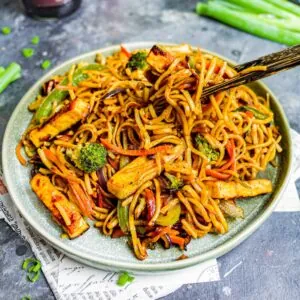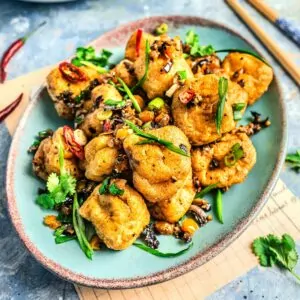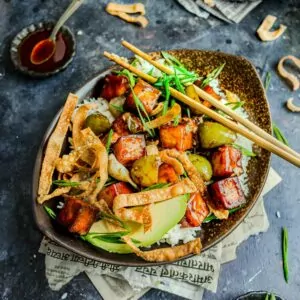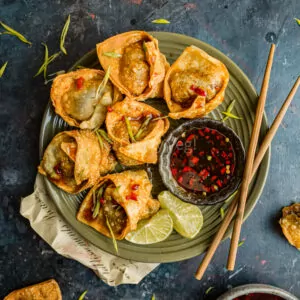Plain Chow Mein, Soy Sauce Fried Noodle Takeaway-Style
Just imagine: soft noodles and crunchy beansprouts tossed in an umami-rich, salty, and deeply savoury sauce. The soy sauce fried noodles or plain chow mein are irresistibly moreish — guaranteed to have you reaching for your wok rather than your takeaway menu!
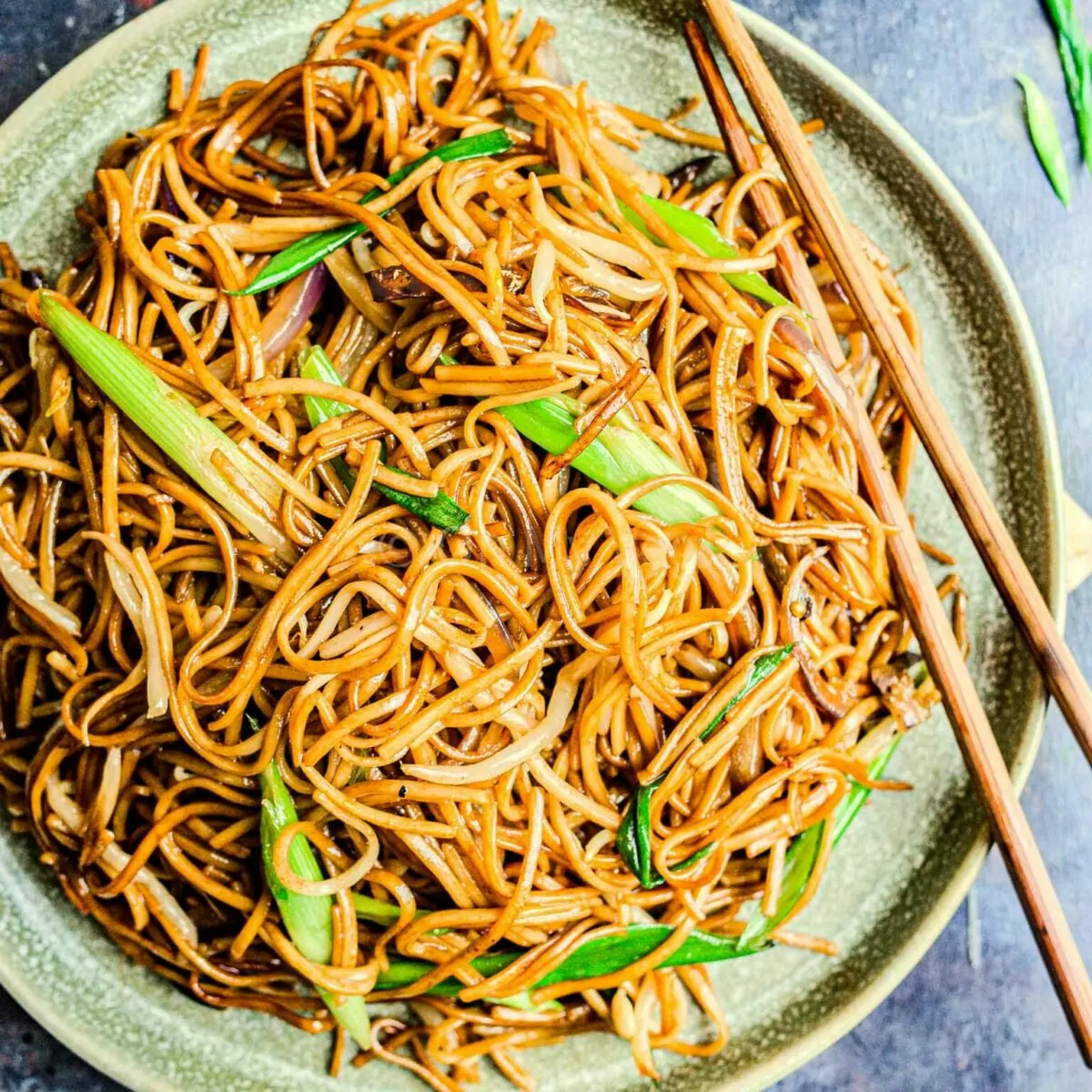
Along with egg fried rice, these plain chow mein noodles are the backbone of a great Chinese takeaway. After all, what are dishes like creamy tofu satay curry without a side of soft noodles with beansprouts (as they’re called in the U.K.) on the side?
While I’ve already posted my take on vegetable chow mein noodles, an undisputed takeout favourite, I figured it was about time I shared this knockout recipe too.
Plus, these plain chow mein noodles (which may be plain in name, but not in flavour) are cheaper than takeaway … and quicker too! In less than 15 minutes you can have a steaming hot plate of soft noodles in front of the whole family.
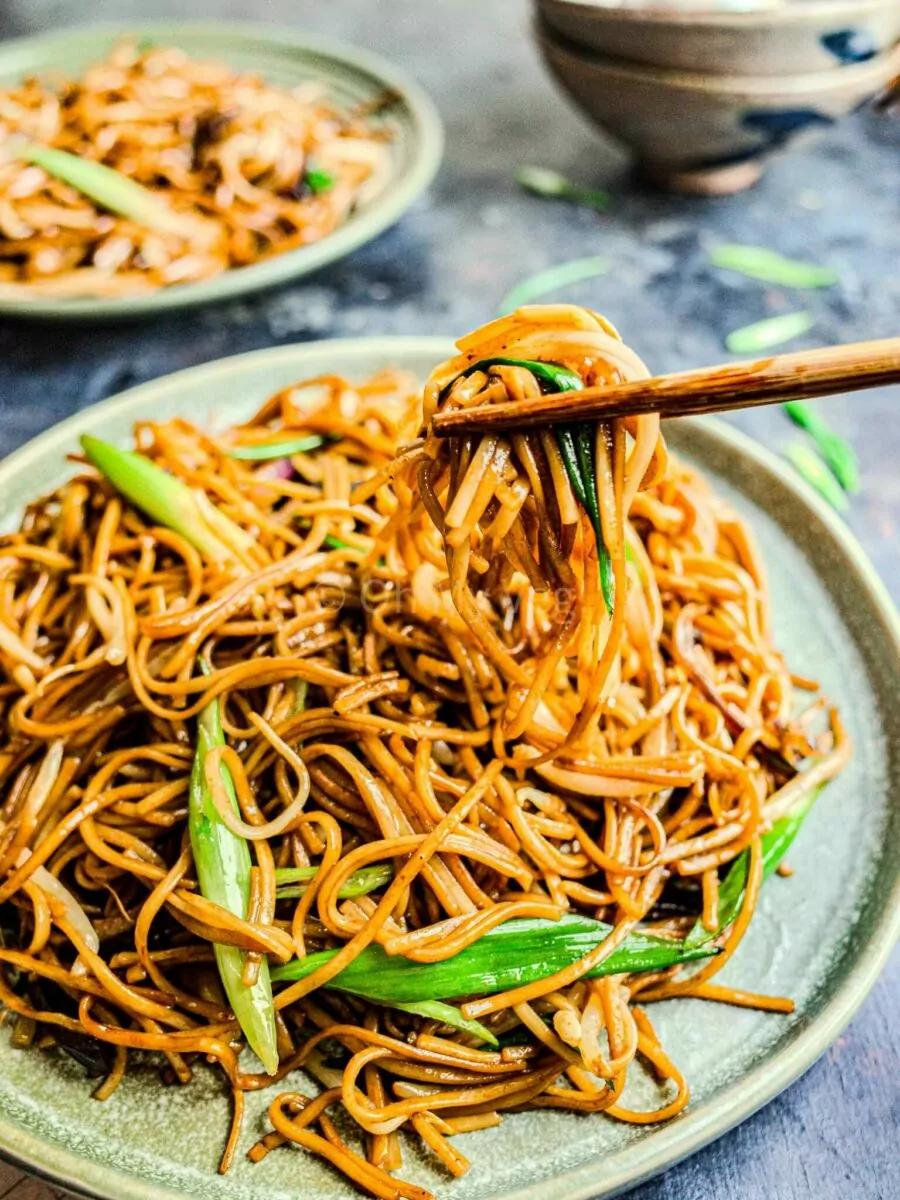
What is Plain Chow Mein Noodles Made Of?
You’ll only need a handful of ingredients for this basic recipe: noodles, onions, beansprouts, seasonings, and garnishes. If you cook Chinese takeaway-style food regularly, you’re sure to have all the components to hand!
- Chow mein noodles are ideal for this recipe. Lucky Boat No. 1 noodles are widely used across takeaways in the U.K. and are coincidentally vegan; alternatively, you can use ramen or udon noodles.
- Neutral oil is necessary for stir-frying the onions, beansprouts, and noodles together. I like sunflower or rapeseed oil.
- Onion is 100% optional but adds a gorgeous mellow sweet flavour and slight crunch.
- Beansprouts provide fresh crispness to the chow mein. It’s a must!
- Light soy sauce adds an intensely salty nuttiness characteristic of takeaway-style plain chow mein noodles.
- Dark soy sauce lends these soft noodles with beansprouts the distinctive dark brown colour and mature, umami-packed taste.
- Vegan oyster sauce builds layers of balanced salty-sweet-umami. It’s usually made from mushrooms, which boosts the “meaty” seasoning. This is often branded as “vegetarian stir-fry sauce” yet is usually vegan (check the label!).
- Salt, just a touch, brings everything together.
- Sugar doesn’t make the noodles taste sweet, instead marrying exquisitely with the powerful savoury notes.
- Spring onion adds much-needed garlicky greens to the recipe. Chinese garlic chives are the authentic option, but spring onion (or scallions, to my U.S. readers) are a wonderful substitute.
For a genuine takeaway-style taste, use a pinch of Ajinomoto or MSG. Most Chinese restaurants use the ingredient, so if it feels like something is lacking, it’s probably the fact you haven’t added MSG. Despite common misconceptions, MSG isn’t generally harmful to our health. It’s just pure umami flavour — but I love the flavour of these noodles even without the added seasoning.
Plain Chow Mein Allergens and Substitutions
Ordering out is always risky when you have allergies or dietary requirements. That’s one of the main reasons I learned to cook at home, and why my fakeaway style recipes are enduringly popular!
Luckily, these soft noodles with beansprouts are suitable for such a wide range of needs. For example, this plain chow mein recipe is 100% vegan. Unlike takeaways and restaurants, we’ll use vegan oyster sauce (made from mushrooms) and no other nasties or artificial flavourings.
- To make plain chow mein noodles gluten-free, you’ll have to make a few swaps. But don’t worry, they’re extremely straightforward, no-fuss substitutions.
- To make the Cantonese soy sauce fried noodles soy-free, sub the soy sauce products with coconut aminos. You’ll also need to replace the vegan oyster sauce with extra coconut aminos and shiitake mushroom extract (for that deeply meaty umami!).
These plain chow mein noodles are also nut-free, alcohol-free, halal, and kosher — ideal for hosting a huge homemade Chinese takeaway night!
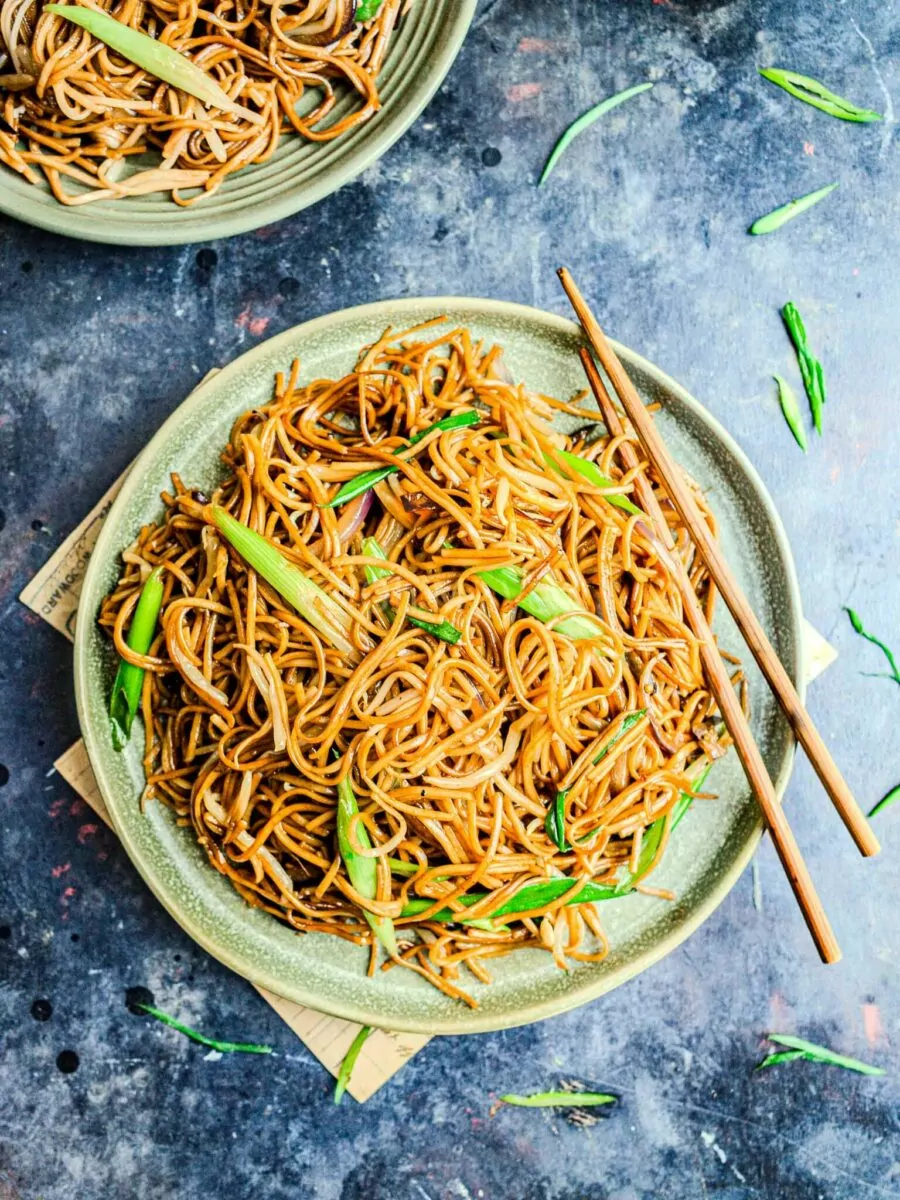
How to Make Soft Noodles like a Chinese Takeaway
Can you believe it takes less than 15 minutes and only FOUR effortless steps to make restaurant-worthy soft noodles with beansprouts? Honestly, just look at the instructions:
- Par boil your noodles according to package instructions and drain.
- Mix the sauce with sugar, both types of soy sauce, vegetarian oyster sauce, and salt.
- Stir fry the onion, beansprouts, and noodles for a minute.
- Add the sauce to the wok and toss everything together with spring onions or garlic chives.
Unbelievably straightforward, right? This recipe is easy as chips — it’s a great dish to build confidence in the kitchen or effortlessly whip up alongside other takeaway-style dishes. The full details are in the recipe box below, along with ingredient quantities.
My Expert Tips for the Best Plain Chow Mein Noodles
It’s true — this recipe is unbelievably easy. It was one of the first things I learned to cook in the kitchen! However, there are always a few extra “professional” tips that can make the cooking experience smooth.
In my experience, these simple adjustments can make your plain chow mein noodles stand out from the pack:
- Don’t overcrowd your wok! The key to achieving “wok hei,” or “the aroma of the wok,” is having plenty of space to toss your noodles around. This will allow you to stir-fry over super-high heat, attaining that restaurant-quality flavour and texture with just a touch of smokiness.
- Prep the ingredients beforehand. Stir-frying is a fast business! You’ll only want to be cooking your ingredients for a maximum of a few minutes. The heat is high, the pressure is on — prep beforehand, and it will cut down on both stress and time.
- Use good quality noodles. Often, poor-quality noodles can boil unevenly and clump together while cooking. See the “What is Plain Chow Mein Noodles Made Of?” for recommendations!
- Once you’ve mastered the dish, play around with the recipe! Add some tofu, seitan, or other vegetables. Or how about, if you’re not vegan, scrambling in some eggs?
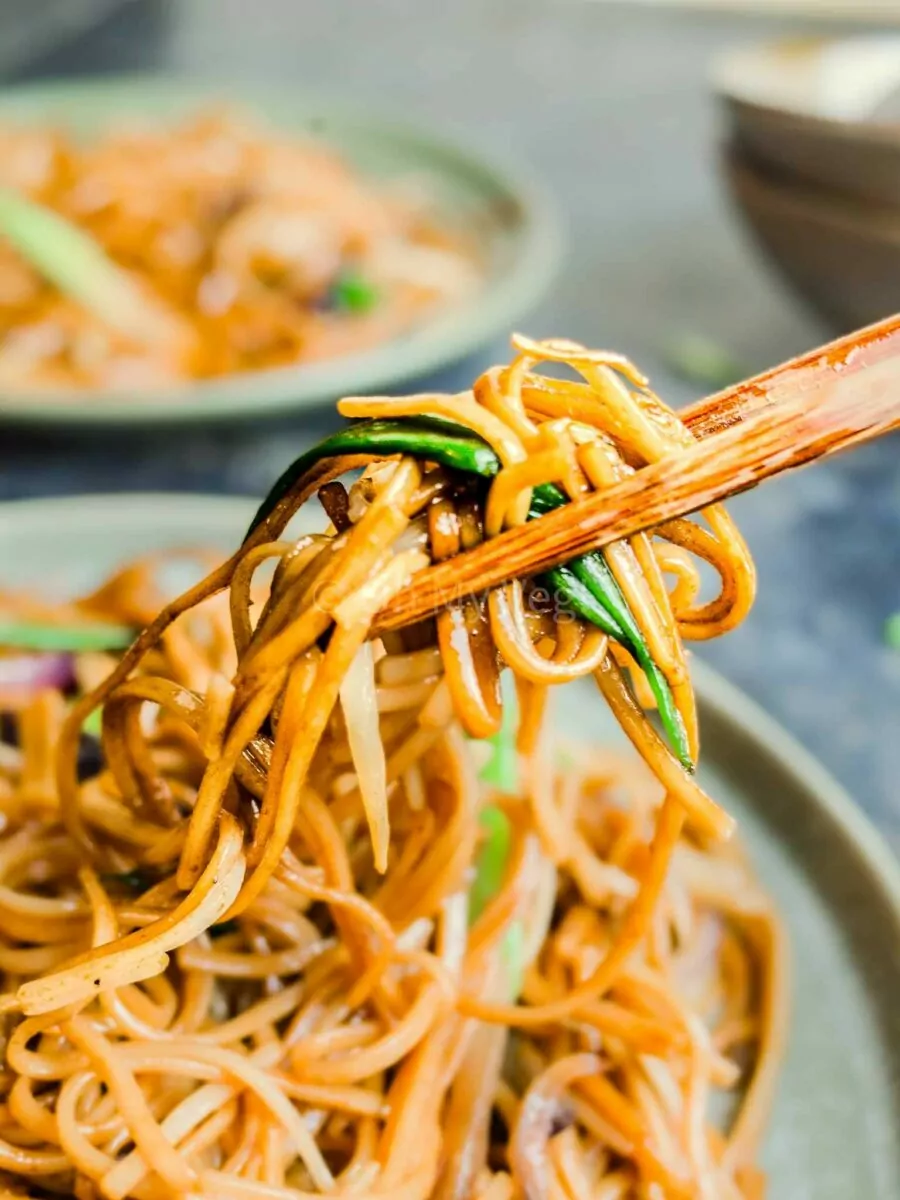
How to Serve Soy Sauce Fried Noodles
In China, traditional Cantonese soy sauce fried noodles are sometimes eaten for breakfast. While that might sound odd to people in the West, it’s hard to argue with the fact that a dish this tasty is great any time of the day!
Personally, I’ve also been known to chow down (excuse the pun!) on the rich noodles without any side dishes! Although, I’m particularly partial to cooking a whole fakeaway-style feast … I’m talking vegetable spring rolls, tofu potstickers, vegan prawn crackers, salt and pepper tofu, vegetable fried rice, and honey garlic tofu.
This Recipe Is:
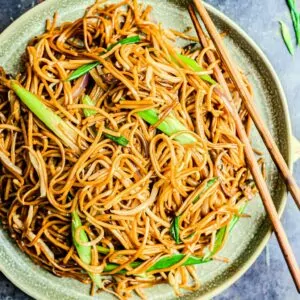
Noodles with Beansprouts, Better than Takeout
Ingredients
- 180 g dried chow mein noodles
- 1 tablespoon light soy sauce
- 1 tablespoon dark soy sauce
- ½ tablespoon vegan oyster sauce/stir-fry sauce
- ¾ teaspoon sugar
- 1 small pinch salt
- 1 teaspoon neutral oil
- 40 g white onion sliced
- 100 g beansprouts
- 1 spring onion cut into pieces
Instructions
- Par-boil 180 g dried chow mein noodles according to package instructions — usually around 3-4 minutes. Drain.
- Mix the sauce in a small bowl. Whisk together 1 tablespoon light soy sauce, 1 tablespoon dark soy sauce, ½ tablespoon vegan oyster sauce/stir-fry sauce, ¾ teaspoon sugar, and 1 small pinch salt. Be wary of the salt, since soy sauce is also high in sodium.
- Heat a large wok over high heat and add 1 teaspoon neutral oil. Once it smokes, add 40 g white onion (sliced) and 100 g beansprouts. Stir-fry for 30 seconds, then add the cooked noodles. Mix well.
- Add the sauce to the wok and toss everything together.
- Garnish with 1 spring onion (or Chinese chives) and serve.




